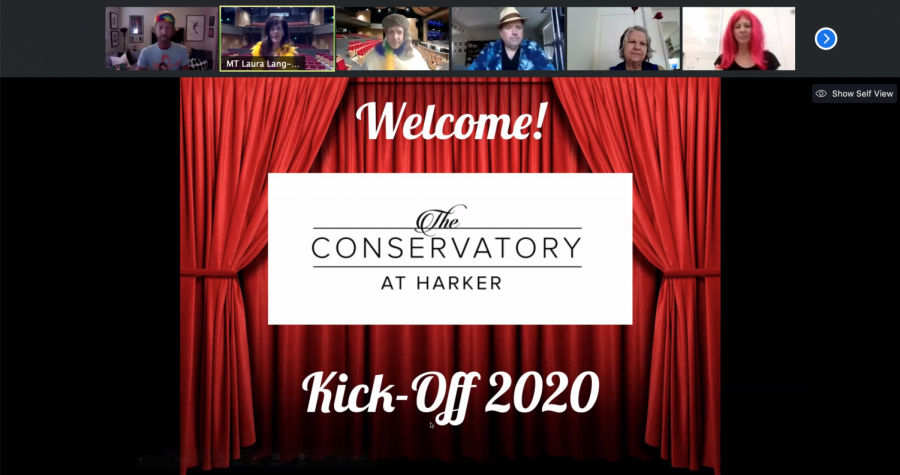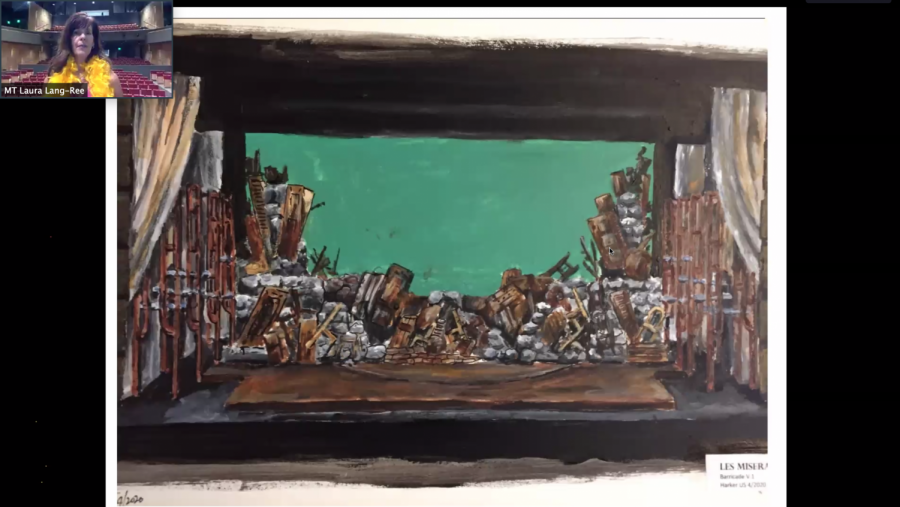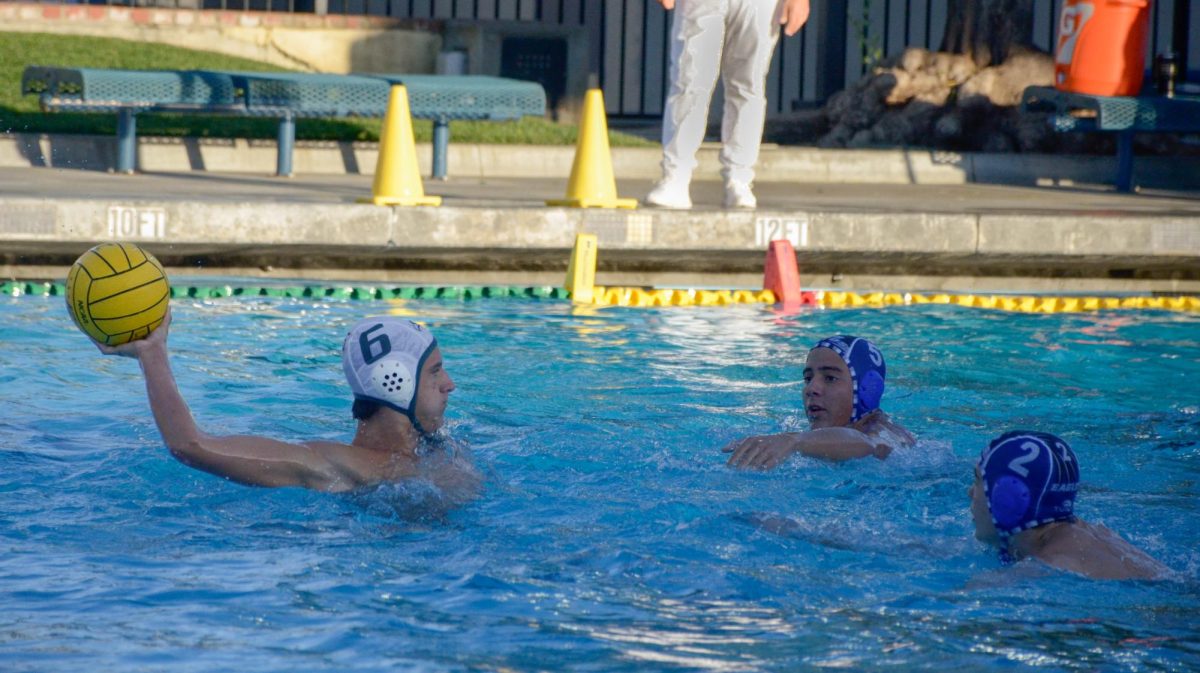“Art has prevailed”: Performing arts prepare versions of shows depending on COVID-19
The Conservatory program held its virtual kick-off on Aug. 26, introducing an unusual year for the arts. “When we had one day to turn around and teach online, it was such an unknown,” said Susan Nace, vocal music teacher and director of Camerata and Cantilena. “Where we are now, it’s not as scary, and we’re seeing a lot of possibilities because we don’t have that fear holding us back.”
September 8, 2020
The end of last year was a devastating time for much of the upper school performing arts department. Both the orchestra trip to Carnegie Hall and the spring musical “Damn, Yankees” were canceled due to COVID-19’s seeming wrath.
Yet, performing arts quickly rebounded and held a video release for the Conservatory’s Senior Showcase and a virtual orchestra and jazz band concert dedicated to the class of 2020, both on May 29.
With health at the forefront, the department will adapt the upcoming year’s performances depending on Santa Clara County regulations. Potential versions include pre-taped performances over Zoom, on-stage recordings stitched into video or normal on-stage productions with a limited audience.
“When we had one day to turn around and teach online, it was such an unknown,” said Susan Nace, vocal music teacher and director of Camerata and Cantilena. “Where we are now, it’s not as scary, and we’re seeing a lot of possibilities because we don’t have that fear holding us back.”
Despite the overt flaws of online learning, performing arts are utilizing the new platform to explore new mediums.
Although options are being kept open, vocal performance groups are preparing for the possibility of being pre-recorded in some capacity. The vocal music classes and orchestra are experimenting with Soundtrap, a digital collaborative tool used to create music where students can asynchronously lay down tracks and edit the music to their liking.
Nace said shifting class time to hold individual appointments with each student last spring allowed for much improvement, and she looks forward to doing the same this year. Moreover, the vocal music teacher hopes to invite speakers to her classes to give workshops.
“We’re learning a lot of new things and it’s an exciting time,” Nace said. “[Online class] is taking us beyond the confines of the regular classroom — we have a different kind of confines, but it creates opportunities for new creativity and exploration and discovery.”
Similar to Nace’s change toward more individualized classes, instrumental music teacher Dr. David Hart is dividing his jazz band and orchestra classes into smaller chamber groups to facilitate interaction. Dr. Hart said he plans to hold virtual concerts with a collage of videos and audio from each player, starting with the annual upper school holiday show.
“Now more than ever, we need music in people’s lives,” Dr. Hart said. “When humans have gone through different times of struggle, no matter what we have a boundless capacity for innovation and ways of expressing ourselves. We’re going to do everything we can to keep that going in our community.”
Like the typical winter concert, students will have the chance to talk about each piece and showcase what they have been working on throughout the semester in virtual concerts.
Theater teacher Jeffrey Draper said the fall play will be recorded on video, some clips potentially recorded in the theater and others on Zoom. Beyond its film nature, the fall play will take on a new format this year as a collection of one-person mini-shows, based on the style of Anna Deavere Smith, an actress famous for her one-woman shows.
The students will interview people around the world, such as a mayor or Bollywood star, and embody them in monologues. Each actor will play at least three characters.
“One quote from Anna Deavere Smith is ‘People speak in poetry,’” Draper said. “You don’t hear it day-to-day, but if you really listen, you’ll start to pay attention to the wisdom in people’s casual conversation. [The students] are going to be repeating those things as they were said to them.”
The fall play will be a six-week process of finding and listening to the monologues, gathering resources, recording and editing the clips, incorporating music and ending with its video release. Depending on the level of interest, there might be two casts, one for underclassmen and one for upperclassmen.
The dance show could range from completely in-person to fully online or a combination of both. Dance teacher Rachelle Haun said the choreographers will adapt their dance compositions to the strengths of Zoom.
“We’re starting to brainstorm a complete overhaul on how we choreograph using the screen [and] utilizing the cool things that we can do in this medium,” Haun said. “We can make things appear and disappear so much easier like this which we can’t do on stage, so I think [this set-up] is a challenge, but it could be a fun challenge.”
Haun said teaching from a screen will be difficult, but she is approaching the problem by using two cameras, one in front of her and one behind, to show choreography from both sides.
In spite of the challenges, Haun looks forward to dance classes and performances as a break from the sedentary and isolating nature of quarantine.
“Being stuck at home and seeing so few people outside of my little house bubble, I’m excited to have that social aspect [of dance],” Haun said. “I’m excited to get off of the computer and jump up and down and spin in circles and literally just move because, man, it feels good after sitting for so long.”
For the spring musical “Les Miserables,” Director of Performing Arts Laura Lang-Ree has three different versions planned: a movie, fully costumed with props and mics sent to students’ homes; a recorded on-stage version; and a normal on-stage version with a reduced audience count.
If in-person acting is allowed for the musical, Lang-Ree said she would make sure that the blocking, which is the positioning of the actors on-stage, is staggered so the students can social distance. The actors would also wear masks right up until the point of filming. Middle school technical theater teacher Paul Vallerga also designed a set using scaffolding to maintain social distancing.
“Art has prevailed over the centuries and millennia,” Lang-Ree said. “As far as there’s been pandemics before and wars and all sorts of huge things, art has come through. So for us to find a way of doing it that’s different and unique, we’re ready to do it. We’re going to make art.”


















![“[Building nerf blasters] became this outlet of creativity for me that hasn't been matched by anything else. The process [of] making a build complete to your desire is such a painstakingly difficult process, but I've had to learn from [the skills needed from] soldering to proper painting. There's so many different options for everything, if you think about it, it exists. The best part is [that] if it doesn't exist, you can build it yourself," Ishaan Parate said.](https://harkeraquila.com/wp-content/uploads/2022/08/DSC_8149-900x604.jpg)




![“When I came into high school, I was ready to be a follower. But DECA was a game changer for me. It helped me overcome my fear of public speaking, and it's played such a major role in who I've become today. To be able to successfully lead a chapter of 150 students, an officer team and be one of the upperclassmen I once really admired is something I'm [really] proud of,” Anvitha Tummala ('21) said.](https://harkeraquila.com/wp-content/uploads/2021/07/Screen-Shot-2021-07-25-at-9.50.05-AM-900x594.png)







![“I think getting up in the morning and having a sense of purpose [is exciting]. I think without a certain amount of drive, life is kind of obsolete and mundane, and I think having that every single day is what makes each day unique and kind of makes life exciting,” Neymika Jain (12) said.](https://harkeraquila.com/wp-content/uploads/2017/06/Screen-Shot-2017-06-03-at-4.54.16-PM.png)








![“My slogan is ‘slow feet, don’t eat, and I’m hungry.’ You need to run fast to get where you are–you aren't going to get those championships if you aren't fast,” Angel Cervantes (12) said. “I want to do well in school on my tests and in track and win championships for my team. I live by that, [and] I can do that anywhere: in the classroom or on the field.”](https://harkeraquila.com/wp-content/uploads/2018/06/DSC5146-900x601.jpg)
![“[Volleyball has] taught me how to fall correctly, and another thing it taught is that you don’t have to be the best at something to be good at it. If you just hit the ball in a smart way, then it still scores points and you’re good at it. You could be a background player and still make a much bigger impact on the team than you would think,” Anya Gert (’20) said.](https://harkeraquila.com/wp-content/uploads/2020/06/AnnaGert_JinTuan_HoHPhotoEdited-600x900.jpeg)

![“I'm not nearly there yet, but [my confidence has] definitely been getting better since I was pretty shy and timid coming into Harker my freshman year. I know that there's a lot of people that are really confident in what they do, and I really admire them. Everyone's so driven and that has really pushed me to kind of try to find my own place in high school and be more confident,” Alyssa Huang (’20) said.](https://harkeraquila.com/wp-content/uploads/2020/06/AlyssaHuang_EmilyChen_HoHPhoto-900x749.jpeg)












